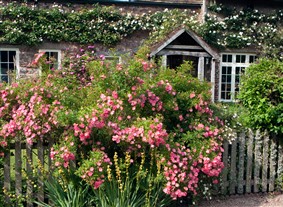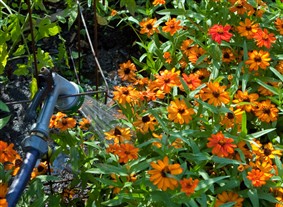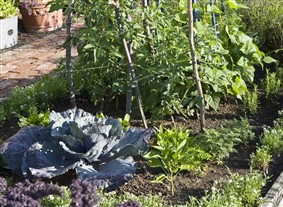Creating Enclosed Gardens
Views: 10405

Building a wonderful kitchen garden is more than planting a few raised beds of vegetables. Its design success depends on creating boundaries.
The very first enclosed gardens were tucked behind walls of stone or fences of woven wood. The stone walls protected the delectable edibles from roving animals and bandits. But it also then created microclimates of warmth for espaliered pears, apples and figs.
Wattle fences were woven from nearby saplings of willow or osier wood. The fences outlined the space of the garden so that it had an inside and an outside, a beginning and an end. The word “wattle” in early English was used interchangeably with the word “garden”. Then the medieval man understood the word wattle to mean garden.
The medieval cloister garth, or hortus conclusus, was an enclosed garden open to the sky. Symbolically and practically these early kitchen gardens were walled gardens set apart as special places.
Ideas for Enclosed Gardens
The enclosure of the kitchen garden is what makes the kitchen garden truly a garden—a destination. There are many ways to create enclosure. Borrow the wall of a garage or shed, erect a picket fence, or build a stone wall. Even some well placed trees and shrubs can form the edge to the garden.
My backyard potager is surrounded by a picket fence that has been left to weather to a brown gray. The fence runs the length of my house with two gates at each end forming a rectangle that encloses my brick walkways and raised beds. Inside I’ll then pack in a variety of seasonal flowers, herbs, and vegetables.
Evergreens like holly, yew, or boxwood can create hedges of any height depending on your design. Climbing roses cascading over fences or clambering up gate posts provide color and fragrance to the kitchen garden while forming a boundary. Hardy, disease-free shrub roses planted close together will then create a low floriferous hedge.
What to Plant in an Enclosed Garden
This summer, I have been building a stone wall for my front yard to create a portico of sorts. The wall will form the backbone edge to an edible and seasonal entrance garden at my front door.
The walled garden will be filled with perennial edibles like currants, rhubarb, espaliered apples, strawberries, and flowers that bloom from early spring until past frost. Winter berry and willow will provide winter color. The purpose of the garden is to demonstrate how we can grow our own flowers and decorations for the vase or wreath as well as something to eat for the table.
I will leave some space for annual vegetables like tomatoes and peppers but the emphasis on this front yard garden is seasonal, perennial color. The garden is featured in my forthcoming book: The Kitchen Gardeners Handbook, published by Timber Press.
I have watched with delight as the artisan stone mason has incorporated found boulders from my property with layers of thick gray blocks of stone and narrow bands of buff limestone. He is building a work of art that will be the centerpiece of my new seasonal and useful edible garden.
Meet Jennifer Bartley
Jennifer Bartley grew up on a ravine near an ancient Indian mound. She remembers spending glorious childhood days picking wildflowers and playing in an old,…
Jennifer's Recent Posts

Hand Watering the Kitchen Garden








